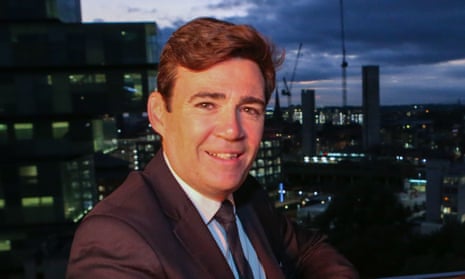The mayor of Greater Manchester, Andy Burnham, has pledged to make the region carbon neutral by 2038,more than a decade earlier than the target date adopted by the European commission, at the unveiling of a new industrial strategy.
But Burnham was quickly accused of peddling “empty rhetoric” because of the regional authorities’ majority stake in Manchester airport, which aims to double passenger numbers over the next 20 years, and plans to spend £6bn on new roads.
While Burnham said he wanted Manchester to be the “greenest city region in the UK”, Pete Abel of Manchester Friends of the Earth said the current plan would blow “our carbon-budget twice over, putting us on a path to climate chaos”.
Abel welcomed Greater Manchester signing up to the 2038 carbon-neutral plan and for setting a science-based carbon budget, but said: “We need to urgently pull the plug on plans that will increase climate-wrecking emissions. Unless Greater Manchester stops planning to build more roads and double passengers flying from Manchester airport, then the climate plan will just look like empty rhetoric.”
Burnham said it was not hypocritical to make his pledge despite Greater Manchester councils owning 65% of the airport and air travel being a major producer of carbon emissions. “Aviation is a national and international issue, it’s not something that a region can influence,” he added.
The mayor, who has frequently called for more powers at a local level, aid any attempts to cut air travel should be made byWestminster. “I am all in favour of tough decisions at a national level. I don’t believe there should be a third runway at Heathrow, for instance. But I think those are decisions for national government,” he said.
Manchester airport wants to increase passenger numbers from more than 25 million to 45 million by 2040, but Burnham insisted that growth could come from other UK airports.
“I’m not necessarily calling for more flights to the UK – it might mean taking passengers from other places,” he said. “But there is a debate to be had about aviation isn’t there? There are changing public attitudes about aviation. Rather than just saying no to people flying, don’t we need to accelerate research into low and zero carbon forms of aviation?”
Greater Manchester’s new industrial strategy also talks about reducing car use to no more than half of all daily trips by 2040 – “this will mean finding ways to create a radical change in behaviour, with a million more trips each day using public transport, cycling and walking”.
Though Burnham has committed £160m for the development of Greater Manchester’s “bee network” of safe routes to walk or cycle, almost £6bn of road schemes are being mooted in the region, including £5.4bn for an extension to the M60 and M62 near Bolton and £477m for a motorway link through the Goyt valley in Stockport.
On Wednesday Manchester city council announced plans for a £9.1m revamp of Great Ancoats Street, a key commuter route just outside the city centre, which did not include any provision for cyclists.
The council signed up last year to a manifesto proposed by Chris Boardman, the Olympic gold medal-winning cyclist who is Greater Manchester’s walking and cycling commissioner. The manifesto promises to “ensure all upcoming public realm and infrastructure investments, alongside all related policy programmes, have walking and cycling integrated at the development stage”.
Sir Richard Leese, the longstanding leader of the city council, said the Great Ancoats Street redesign aimed to “take traffic out of the city centre” and included multiple pedestrian crossings. A new cycling route would run parallel to it on quieter roads, he said.
